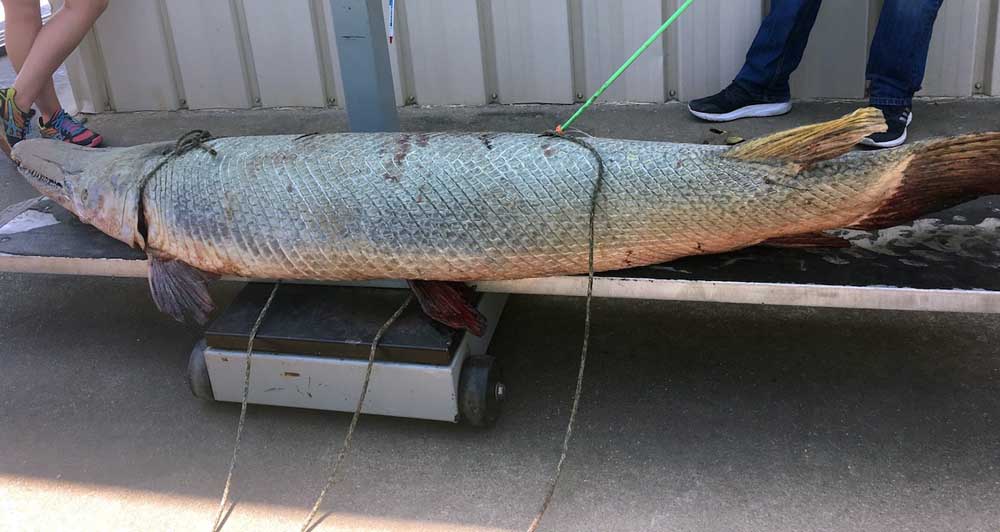Trophy Tags: TPWD Accepting Applications For Trinity River Trophy Gar Tags
Published 1:44 pm Saturday, August 31, 2019

- With potential trophies like this 197-pound, 7.39-foot fish from the Brazos River, alligator gar fishing has become popular with bow fishermen and others statewide. In an effort to protect fish numbers on the Trinity River, TPWD will hold a drawing for trophy permits.
Applications are being taken for a drawing for 150 alligator harvest permits to be used on portions of the Trinity River. The drawing is a result of regulation changes adopted by the Texas Parks and Wildlife Commission at its March meeting.
Going into that meeting some on the commission were pushing a restrictive proposal that called for a 48-inch maximum length limit on alligator gar harvested from the Trinity River, a permit draw program on the river from I-30 in Dallas to I-10 in Chambers County, a one-fish statewide daily limit and a controversial ban on all night fishing for alligator gar.
Trending
In the end the night fishing ban, which impacted primarily bow fishermen, was dropped everywhere except that portion of the Trinity River now under the permit program. There, night fishing with a bow or crossbow is illegal from one-half hour after sunset to one-half hour before sunrise except for those drawn for one of the trophy fish permit.
TPWD began accepting applications for the drawing Aug. 15 through its My Texas Hunt Harvest mobile app or online at https://apps.tpwd.state.tx.us/huntharvest/fishing/fishing.faces. Fishermen with a 2019-2020 license can continue to apply for the permit through Sept. 30. There will be a drawing Oct. 15 and the permit will be good throughout the license year ending Aug. 31, 2020.
Guides may not use permits for clients, nor may fishermen drawn for a permit give their permit to someone else. However, in an effort to allow friends to fish together the department will accept applications for parties of up to four fishermen. Each will receive a permit and the fishermen are not required to fish together from the same boat.
The permits are not just for bow fishermen. They are for anyone using any legal means to catch and keep alligator gar.
“This segment of the Trinity River has become one of the most popular destinations in the world to catch a large alligator gar, but concerns have recently been raised about the potential for overharvest and its risks to fishing quality,” explained Craig Bonds, inland fisheries director. “With the new drawing system being implemented this year, we will be able to give 150 anglers the opportunity to harvest the fish of a lifetime while also meeting our management goal to conserve this unique resource for current and future generations of anglers.”
Other than Dallas and Chambers counties, alligator gar fishing on the Trinity River will be impacted in Anderson, Ellis, Freestone, Henderson, Houston, Kaufman, Leon, Liberty, Madison, Navarro, Polk, San Jacinto, Trinity and Walker counties.
Trending
In contrast to the remainder of the state where the daily limit on alligator gar is one, the limit at Falcon International Reservoir is five. The liberal limit there is the result of concerns by bass fishermen on the lake who believe alligator gar feed on sport fish during periods of low water causing numbers to decline.
“After discussions of alligator gar population estimates in the Trinity River between staff and the commission, the 150 number was chosen as a conservative total for harvest opportunities for fish over 48 inches,” Bonds explained of the process used for determining the number of permits.
The strict controls over alligator gar fishing are a result of a nationwide concern over fish numbers. With less spring river flooding, conditions needed for the fish to spawn are believed to be leading to declining numbers in Texas.
Alligator gar need water temperatures between 68 and 82 degrees and flood-like conditions in river basins or rising water in or above a reservoir to spawn. The fish typically do not spawn until about the age of 8, and may only spawn once or twice every 10 years. They can live to be 70 or older.
TPWD has had the ability to close portions of the Trinity to fishing in the spring if spawning conditions are right. It used that authority for about three weeks in May.
Alligator gar are both a predator and scavenger feeding mostly on shad, catfish, buffalo and other fish, but are also known to take sport fish such as bass when the opportunity presents itself.
The department has been monitoring alligator gar populations for more than a decade and generally describes the statewide population as good and has noted the statewide harvest rate is estimated to be below what is believed a sustainable level.
While the fish can be found almost statewide, the better populations tend to be in East and South Texas. Along with the Trinity, other good river populations can be found in the Sabine, Brazos and Lower Guadalupe. Good reservoir populations are found in Choke Canyon, Sam Rayburn, Falcon, Livingston and Corpus Christi. Brackish waters in some coastal bays and estuaries also have good populations of alligator gar. Fishermen throughout the state, with the exception of Falcon, are also now required to notify the department when they take an alligator gar using the same app or website used for the Trinity River drawing.
“Mandatory harvest reporting data will be used to inform future fisheries management decisions,” Bond said. He added that at this time none of the state’s other fisheries other than the Trinity River are facing a permit system, and that using the data received from fishermen, the number of harvest authorizations allotted could be adjusted in the future.



